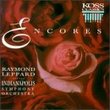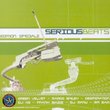| All Artists: Peter Maxwell Davies, Wallace Title: Trumpet Concerto Members Wishing: 0 Total Copies: 0 Label: Collins Classics Release Date: 8/24/1993 Genre: Classical Styles: Forms & Genres, Concertos, Historical Periods, Modern, 20th, & 21st Century, Instruments, Brass, Symphonies Number of Discs: 1 SwapaCD Credits: 1 UPCs: 5012106118126, 723721378325 |
Search - Peter Maxwell Davies, Wallace :: Trumpet Concerto
 | Peter Maxwell Davies, Wallace Trumpet Concerto Genre: Classical
|
CD DetailsSimilar CDs
|
CD ReviewsSymphony #4 the gem allen defowler | Hartford, CT United States | 02/22/2003 (5 out of 5 stars) "This compact disc contains two works by composer Peter Maxwell Davies. The first is a trumpet concerto for trumpet and orchestra. While Davies always manages to deliver a soundscape of incredible integrity whilst making provision for a solution to temporal structure problems in compositions such as the two on this recording, the production values for the trumpet concerto left a bit to be desired. As in this case of many concerto recordings, the soloist is placed with to much presence in the recording, the usually vast spaces of the concert hall, which provide a sonic shaping of brass timbre, is absent in the soloists microphone placement view. Nevertheless, Collins Classics are to be commended for fortitude and vision in recording this essential contemporary music series. All five of the davies symphony recordings are exquisite with outstanding production values. Highly recommended for the 20th century musicologist." Some notes on Trumpet Concerto (only recording of this work) allen defowler | 10/01/2002 (5 out of 5 stars) "Peter Maxwell Davies composed his Concerto for Trumpet and Orchestra for John Wallace and the Philharmonia Orchestra, who premiered the work in 1988. The composer conceived it partially as a preparatory exercise for a projected chamber opera, Francis of Assisi; the trumpet thus can be seen as the protagonist in a drama. Still, the concerto certainly stands on its own without benefit of an externally applied "program" -- in fact, considered in the abstract, this is one of Davies' most powerful and emotionally involved instrumental works. The Trumpet Concerto plays upon conventions by fusing the traditional three movements of the concerto into a single, continuous span. It begins with a brooding Adagio emerging from the lower winds and brass. Though it gradually gains some momentum and mass, it makes no improvement in disposition; by the time the featured trumpet enters, it does so against a rather ominous orchestral background. The soloist's lines are amorphous and irregular in contour, and its melodic leaps and runs are calculatedly misaligned with its complex and ever-changing rhythmic scansion. Proceeding in fits and flurries, the trumpet and orchestra finally propel themselves into an Allegro -- one that, though more driven and articulate than the preceding Adagio, remains rhythmically fluid. Particularly effective here is Davies' integration of the orchestra and soloist, as demonstrated by his pairing of trumpet and percussion. At several points, the trumpet carves out a vigorous line whose general dimensions and angles are inexactly mimicked by or counterpoised with freely drawn corollaries in the glockenspiel or crotales, creating melodic gestures with an engaging sense of three-dimensional shape and depth.Just such a climactic figure -- a series of rapid sequential descents in the trumpet abstractly sketched over by the percussionist -- precedes the point of exhaustion and recess from which the subsequent Adagio molto (functioning as a middle concerto movement) proceeds. It begins with the trepidation of the opening, but follows the steadier and more discernible pace of short repeated chords in the strings. The soloist's material is much more reserved and uncomplicated, while the accompaniment becomes increasingly turbulent -- first in the nervous string tremolos, then in the clarinet's quiet chromatic waves and the trombones' dark counterpoint. Finally an ostinato in the marimba initiates an exponential swell of ominous noise that tests the bounds of the bearable before subsiding into an eerily hushed, orchestra-wide canon of southbound glissandi. A stark dialogue between the horn and soloist closes this section.The Presto finale begins quietly, but with a heretofore absent rhythmic energy maintained by pointed accompanimental gestures and driving percussion, as well as the double-note runs exchanged between the solo trumpet and marimba. This energy is spent fairly quickly, however, as the orchestra cedes to the trumpet's obligatory closing cadenza. Here Davies plays his cleverest trick of all, however: after an initially flashy extemporization, the trumpet actually steps out of the spotlight, allowing virtually all the other instruments to finish off the work with a dizzyingly complex orchestral cadenza. -- J. Neal (from the All Classical Guide)" Some notes on Symphony No. 4 allen defowler | 10/01/2002 (5 out of 5 stars) "Peter Maxwell Davies' close relationship with the Scottish Chamber Orchestra had a profound impact on his musical output, including, perhaps most notably, the composition of ten Strathclyde Concertos, each featuring one or more of the principal players in the ensemble. Likewise, his work as associate conductor/composer of the group provided Davies with an intimate perspective on the works of the Classical masters, instilling in him a desire to explore instrumental sonorities within the conservative resources of a Haydnesque or Mozartian orchestra. Composed in 1989 as a memorial to the group's former director, John Tunnel, Davies' Symphony No. 4 is a direct outgrowth of this undertaking, utilizing as it does scaled-down instrumental forces, but creating no less intense a musical experience. "This was just a continuation of the way that the symphonic thought was going -- it becomes more concentrated and focused," Davies tells us. "Writing for this kind of orchestra seems the most natural thing, and I feel that the Symphony No. 4 is no less concentrated or symphonic than the others -- it's just that its orchestral sound is not as loud."
The work draws freely upon two distinct inspirations, one musical, and one experiential. Like many of Davies' compositions, the Fourth Symphony incorporates plainchant materials; here Davies utilizes a version (taken from a manuscript source rather than the standard Liber Usualis) of a chant from the Feast of the Purification of the Virgin Mary, Adorna thalamum tuum, Sion (Adorn your bridal chamber, Daughter of Zion). The chant is sung during a solemn candlelight procession during the Feast Day (which, incidentally, corresponds with the composer's September 8 birthday). Davies here puts it through a rigorous series of transformations, the parameters of which he mulled over before even putting pen to paper. The more poetic inspiration for the symphony came to Davies early one morning as he stepped out onto his front porch to find himself caught in the stare of a golden eagle perched on his fence. "He took off," recalls Davies, "slowly unfolding a huge wingspan, floating upwards with an overwhelming grace-in-strength -- the while regarding me with icy disdain -- and moved slowly out to sea, against the rising sun. This vision has haunted me, and although the music does not attempt to portray the flight literally, I hope something of the reverberations of that extraordinary moment come through."The Symphony No. 4 is cast in four movements, performed without interruption and structured according to Davies' characteristically playful subversions of formal traditions. The first, Moderato, broods throughout, and seems to wind down towards a slower second section; but this is only a ruse. The second movement Scherzo appears instead, which, coupled with the third movement's Adagio, seems to set up a scherzo-trio form. The former material fails to return, however, and the fourth movement begins right away, opening with an Adagio and then moving into a concluding Allegro. -- J. Neal" |

 Track Listings (7) - Disc #1
Track Listings (7) - Disc #1


